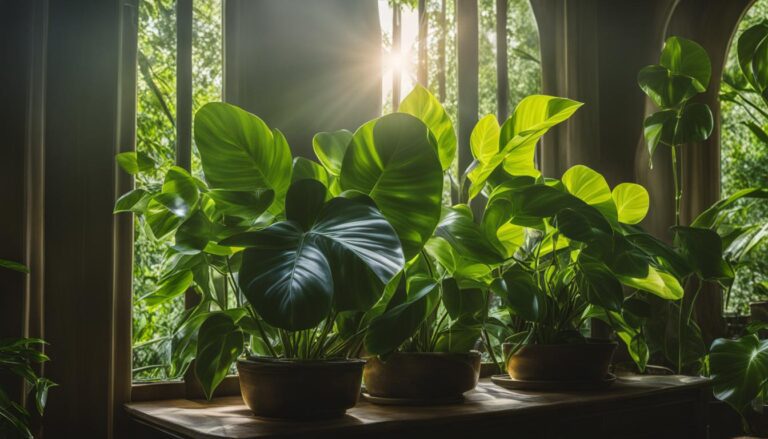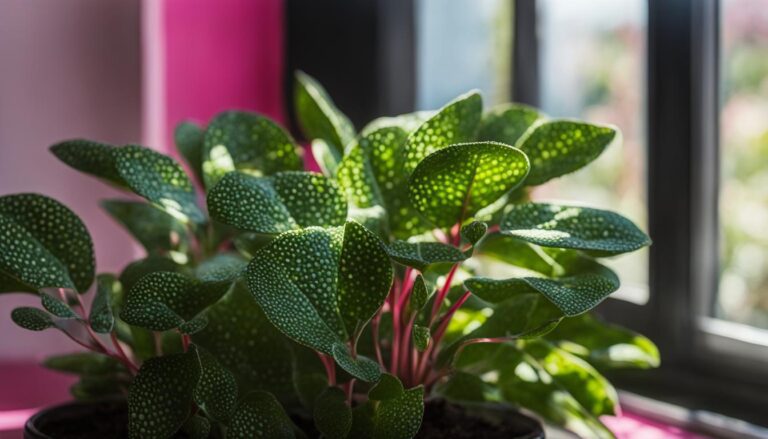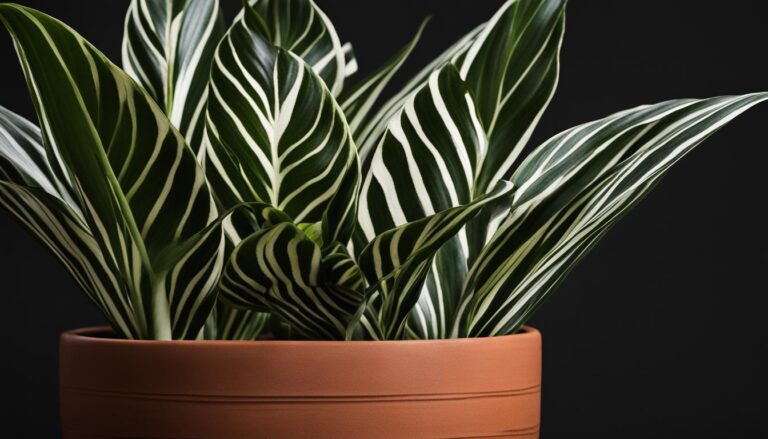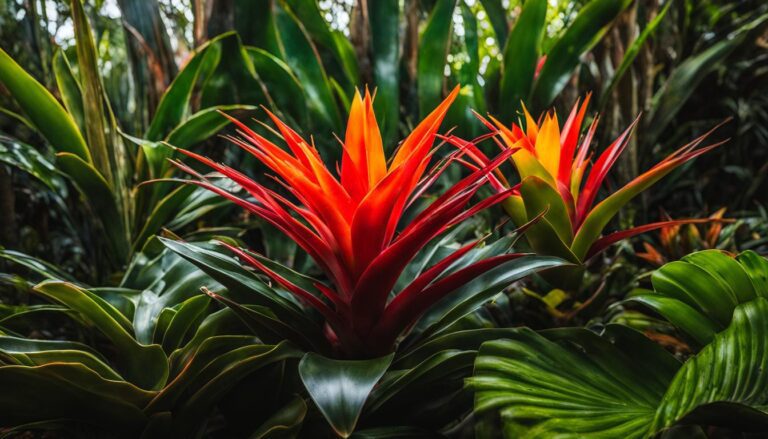
Indoor air pollution is a common problem that can have negative effects on our health. From harmful chemicals to volatile organic compounds (VOCs), the air we breathe indoors can be filled with pollutants.
But did you know that there is a natural remedy for improving air quality in your home? Medicinal plants have the incredible ability to act as natural air purifiers, effectively removing toxins and enhancing the overall air quality.
In this article, we will explore the benefits of using medicinal plants to improve the air quality in your home and create a healthier living environment.
Key Takeaways:
- Medicinal plants can improve air quality in homes by acting as natural air purifiers.
- Indoor air pollution can have detrimental effects on health, leading to respiratory problems and allergies.
- Certain houseplants, like snake plants and peace lilies, have air-purifying qualities and can effectively remove toxins from indoor air.
- Indoor plants not only enhance the aesthetic appeal of a space but also contribute to air purification and mental well-being.
- Improving indoor air quality naturally involves incorporating air-purifying plants, proper ventilation, regular cleaning, and reducing the use of chemical-based products.
How Indoor Air Pollution Affects Health
Indoor air pollution can have serious implications for human health, leading to various respiratory problems and allergies. The presence of harmful substances such as volatile organic compounds (VOCs), formaldehyde, and benzene in indoor air can contribute to poor air quality and impact the well-being of individuals.
These pollutants can be emitted from a range of sources including building materials, household cleaning products, and even common furnishings.
The Health Effects of Indoor Air Pollution
- Respiratory problems: Prolonged exposure to indoor air pollution can cause or exacerbate respiratory conditions such as asthma, bronchitis, and allergies.
- Allergies: Indoor air pollutants can trigger allergic reactions in susceptible individuals, leading to symptoms such as coughing, sneezing, and watery eyes.
- Poor immune function: Breathing in contaminated air on a regular basis can weaken the immune system, making individuals more susceptible to infections and illnesses.
- Neurological effects: Some studies have suggested a link between indoor air pollution and cognitive impairments, including reduced concentration and memory problems.
Understanding the health effects of indoor air pollution is crucial in order to implement effective measures to improve air quality and protect our well-being. One way to combat indoor air pollution is by introducing medicinal plants with air-purifying properties into our homes.
These plants have the ability to remove toxins from the air, creating a cleaner and healthier environment for us to live in. By utilizing natural remedies such as medicinal plants, we can take proactive steps to mitigate the negative impact of indoor air pollution on our health.
| Pollutant | Health Effects |
| Volatile Organic Compounds (VOCs) | Eye, nose, and throat irritation; headaches; dizziness; damage to liver, kidneys, and central nervous system |
| Formaldehyde | Irritation of the respiratory system; eye, nose, and throat irritation; increased risk of asthma and allergies |
| Benzene | Headaches; drowsiness; dizziness; increased risk of leukemia and other cancers |
Natural Air Purifying Plants for Better Indoor Air Quality
In the quest for cleaner indoor air, incorporating natural air purifying plants into your home can have significant benefits. These plants have the ability to cleanse the air by absorbing harmful chemicals and releasing oxygen, improving the air quality and creating a healthier living environment.
There are several houseplants that are known for their air-purifying properties. The snake plant, also known as mother-in-law’s tongue, is one such plant that effortlessly removes toxins like formaldehyde and benzene from the air.
The spider plant is another popular choice, as it can effectively filter pollutants such as carbon monoxide and xylene. The peace lily is not only aesthetically pleasing but also has the ability to remove ammonia, benzene, and trichloroethylene from the air.
Lastly, the pothos plant is a great air purifier that can remove toxins like formaldehyde and carbon monoxide.
Table: Natural Air Purifying Plants and Their Benefits
| Plant | Air Purifying Benefits |
|---|---|
| Snake Plant | Removes toxins like formaldehyde and benzene. |
| Spider Plant | Filters pollutants such as carbon monoxide and xylene. |
| Peace Lily | Removes ammonia, benzene, and trichloroethylene. |
| Pothos Plant | Removes toxins like formaldehyde and carbon monoxide. |
These natural air purifying plants work by absorbing toxins through their leaves and roots and processing them through various biochemical reactions.
Photosynthesis, for example, helps convert carbon dioxide into oxygen, while symbiotic interactions with microorganisms in the soil aid in the breakdown of harmful chemicals.
By incorporating these air purifying plants into your indoor spaces, you can take a proactive step towards improving the overall air quality in your home.
In addition to their air purifying benefits, these houseplants also add beauty and a sense of tranquility to your space, creating a more welcoming and visually appealing environment.
With proper care and maintenance, these natural air purifying plants can thrive and continue to contribute to better indoor air quality for years to come.
Benefits of Indoor Plants for Air Purification
Indoor plants not only add beauty to our living spaces but also play a vital role in purifying the air we breathe. These green companions have been found to effectively remove toxins and pollutants from indoor environments, improving air quality and promoting a healthier living environment. Here are some key benefits of incorporating indoor plants for air purification:
- Natural Air Cleaning: Indoor plants have the remarkable ability to absorb harmful chemicals and pollutants from the air through their leaves and roots. They act as natural filters, removing toxins such as formaldehyde, benzene, and volatile organic compounds (VOCs) that are commonly found in indoor air. By reducing the presence of these pollutants, indoor plants contribute to cleaner and healthier air quality.
- Increase Oxygen Levels: During photosynthesis, plants take in carbon dioxide and release oxygen, helping to increase the oxygen levels in the surrounding air. This can be particularly beneficial in enclosed indoor spaces where fresh air circulation may be limited. The presence of indoor plants can help to improve oxygen levels, providing a refreshing and revitalizing environment.
- Humidify Indoor Spaces: Some indoor plants release moisture through a process called transpiration. This natural process helps to increase humidity levels in dry indoor environments, adding moisture to the air. By maintaining optimal humidity levels, indoor plants can help alleviate dry skin, respiratory discomfort, and other issues associated with low humidity.
The best indoor plants for air purification:
| Plant | Benefits |
|---|---|
| Aloe Vera | Effective in removing formaldehyde, benzene, and other pollutants |
| Bamboo Palm | Purifies the air by eliminating formaldehyde, benzene, and trichloroethylene |
| Rubber Plant | Filters out formaldehyde and other volatile organic compounds (VOCs) |
| Dracaena | Removes trichloroethylene, xylene, and other harmful substances from the air |

By choosing the right indoor plants and incorporating them into our living spaces, we can enjoy the multitude of benefits they provide. Not only do indoor plants contribute to cleaner and healthier air, but they also create a calming and visually appealing ambiance.
Whether it’s a small potted plant on a desk or a larger statement piece in the living room, the presence of indoor plants can significantly enhance the overall indoor environment.
Moreover, numerous studies have shown that being in proximity to indoor plants can have positive effects on mental health and well-being.
The sight and presence of greenery can help reduce stress, promote relaxation, and improve mood. Furthermore, indoor plants can contribute to noise reduction and act as natural humidifiers, making our indoor spaces more comfortable and pleasant.
In conclusion, incorporating indoor plants for air purification is a simple yet impactful way to enhance the quality of our indoor environments. These natural air purifiers not only filter toxins from the air but also provide numerous additional benefits, such as increased oxygen levels and improved humidity.
By selecting the right plants and integrating them into our living spaces, we can create a healthier, more vibrant, and aesthetically pleasing environment for ourselves and our loved ones.
Best Plants for Home Air Purification
When it comes to improving indoor air quality, choosing the right plants for your home is essential. Certain plants have been found to be particularly effective at purifying the air, making them excellent choices for creating a healthier living environment.
These air-purifying plants not only remove toxins and pollutants from the air but also add a touch of natural beauty to your indoor spaces.
Top Air Purifying Plants for a Healthier Home
Here are some of the best plants for home air purification:
- Aloe vera: Known for its soothing properties, aloe vera is also a great air purifier. It helps to remove formaldehyde and benzene from the air.
- Bamboo palm: This elegant plant is highly effective at removing common indoor air pollutants, including benzene and trichloroethylene.
- Rubber plant: With its large leaves, the rubber plant is known for its ability to remove formaldehyde from the air.
- Dracaena: This versatile plant comes in various types, all of which are excellent air purifiers. They can remove pollutants like benzene, trichloroethylene, and formaldehyde.
By incorporating these plants into your home, you can create a healthier living environment and enjoy the benefits of improved air quality.
Air-Purifying Plants
| Plant | Air-Purifying Benefits |
|---|---|
| Aloe vera | Removes formaldehyde and benzene from the air |
| Bamboo palm | Effective at removing benzene and trichloroethylene |
| Rubber plant | Removes formaldehyde from the air |
| Dracaena | Removes benzene, trichloroethylene, and formaldehyde |
The table above provides a concise overview of some of the best plants for home air purification. Consider incorporating these plants into your indoor spaces to enhance air quality and promote a healthier home environment.
How to Improve Indoor Air Quality Naturally
Improving indoor air quality naturally is essential for creating a healthier living environment. By implementing various air purification methods and natural remedies, you can effectively remove toxins and pollutants from the air, promoting better respiratory health and overall well-being.
One of the most effective ways to improve indoor air quality is by incorporating air-purifying plants into your space. These plants, such as snake plant, spider plant, and peace lily, have the ability to absorb harmful chemicals and convert them into harmless substances through processes like photosynthesis and symbiotic interactions with microorganisms.
In addition to using air-purifying plants, proper ventilation is crucial for maintaining good air quality. Opening windows and allowing for fresh air circulation can help remove stagnant air and introduce cleaner outdoor air into your home.
Regular cleaning is also essential to eliminate dust, pet dander, and other allergens that can contribute to poor indoor air quality.
Natural Remedies for Air Quality Improvement
| Natural Remedies | Description |
|---|---|
| Proper Ventilation | Open windows and doors to allow fresh air to circulate. |
| Regular Cleaning | Remove dust and allergens by cleaning surfaces, carpets, and upholstery regularly. |
| Reducing Chemical-Based Products | Avoid using chemical-based cleaning products, air fresheners, and pesticides. |
| Maintaining Balanced Humidity | Use a humidifier or dehumidifier to maintain optimal humidity levels between 30-50%. |
To further improve indoor air quality naturally, consider reducing the use of chemical-based products in your home. Chemical cleaners, air fresheners, and pesticides can release harmful VOCs into the air, leading to poor air quality.
Opt for natural alternatives and environmentally friendly cleaning products to minimize the introduction of toxins into your indoor environment.
Maintaining balanced humidity levels is another crucial aspect of improving indoor air quality naturally. Too much moisture can lead to mold growth, while low humidity can cause dryness and discomfort.
Use a humidifier or dehumidifier to regulate humidity levels and keep them between 30-50% for optimal air quality.
By implementing these air purification methods and natural remedies, you can significantly improve indoor air quality and create a healthier living environment.
Combining the power of air-purifying plants, proper ventilation, regular cleaning, reduction in chemical-based products, and balanced humidity levels will help you breathe cleaner air and promote overall well-being.
The Role of Plants in Detoxifying Indoor Air
Plants play a crucial role in detoxifying indoor air by absorbing and metabolizing harmful substances. Through a process known as phytoremediation, certain plants have the ability to remove volatile organic compounds (VOCs) and other pollutants from the air, improving indoor air quality.
By understanding the important role of plants in air purification, we can appreciate their potential in creating healthier indoor environments.
One key aspect of plant-mediated air quality improvement is the symbiotic relationship between plants and soil microorganisms. These microorganisms assist in the breakdown and removal of toxins, enhancing the air purification properties of the plants.
Studies have shown that this process is particularly effective in plants such as snake plants, peace lilies, and pothos. Therefore, selecting the right plants with strong symbiotic relationships can maximize air purification benefits.
Plant-Mediated Air Purification and VOC Removal
Certain plants have been found to effectively remove specific VOCs from the air. For example, the snake plant (Sansevieria trifasciata) has been demonstrated to absorb benzene, a commonly found indoor air pollutant.
Another plant with notable air purification capabilities is the peace lily (Spathiphyllum). The peace lily can effectively remove formaldehyde, trichloroethylene, and benzene from indoor air.
In addition to their ability to remove VOCs, plants also have the remarkable capacity to convert carbon dioxide into oxygen through photosynthesis.
This process helps to replenish and improve the oxygen content in indoor spaces, contributing to a healthier environment. By incorporating air-purifying plants into our homes, we can create a natural and effective method of improving indoor air quality.
| Plant | Air Purification Abilities |
|---|---|
| Snake plant | Removes benzene |
| Peace lily | Removes formaldehyde, trichloroethylene, and benzene |
| Pothos | Removes formaldehyde |
The table above highlights some of the plants with air purification abilities and the specific pollutants they can remove. By selecting the right plants based on the pollutants present in our indoor environment, we can optimize the air purification process and create a healthier living space.

In conclusion, plants play a significant role in detoxifying indoor air by absorbing and metabolizing harmful substances.
Through their symbiotic relationship with soil microorganisms and their ability to remove pollutants such as VOCs and convert carbon dioxide into oxygen, plants can effectively improve indoor air quality. By incorporating air-purifying plants into our living spaces, we can create a healthier and more breathable environment for ourselves and our families.
Considerations for Using Medicinal Plants for Air Purification
When using medicinal plants for air purification, several important considerations should be taken into account. It is essential to choose the right plants that are effective in removing specific air pollutants.
Different plants have varying abilities to eliminate toxins and pollutants from the air, so selecting the appropriate species for the desired air purification needs is crucial.
Another factor to consider is the size and layout of the space where the medicinal plants will be placed. Some plants require ample space to grow and thrive, while others can be suitable for smaller indoor environments.
Understanding the space available and the growth requirements of different plant species is essential for ensuring their long-term viability in air purification.
Consideration 1: Specific Air Pollutants
It is important to identify and understand the specific air pollutants present in the environment in order to choose the most effective medicinal plants.
Certain plants excel at removing specific toxins, such as benzene or formaldehyde, while others have a broader range of air-purifying capabilities. Conducting an assessment of indoor air quality can help determine the most suitable plant species for addressing specific pollution issues.
Consideration 2: Maintenance and Care
Proper maintenance and care are crucial for ensuring the continued air-purifying abilities of medicinal plants. Each plant species has specific care requirements, including light exposure, watering frequency, and humidity levels.
It is important to research and understand the specific needs of the chosen plants to provide them with the optimal conditions for growth and air purification. Regular monitoring, pruning, and addressing pest issues are also essential for maintaining the plants’ health and effectiveness in improving indoor air quality.
| Considerations for Using Medicinal Plants for Air Purification |
|---|
| Choose plants that effectively remove specific air pollutants |
| Consider the size and layout of the space |
| Understand maintenance and care requirements |
| Monitor and address plant health and pest issues |
In conclusion, when using medicinal plants for air purification, it is important to consider factors such as the specific air pollutants present, the size and layout of the space, and the maintenance and care requirements of different plant species.
By making informed choices and providing proper care, medicinal plants can effectively improve indoor air quality, creating a healthier environment for residents.
Creating a Healthy Indoor Environment with Medicinal Plants
Improving indoor air quality is essential for creating a healthy environment in our homes. One natural and effective way to achieve this is by incorporating medicinal plants. These plants not only beautify our indoor spaces but also have the remarkable ability to purify the air, removing toxins and pollutants that can harm our health.
Indoor air quality improvement is crucial for our overall well-being, as poor air quality can lead to respiratory problems, allergies, and other health issues. By introducing medicinal plants into our homes, we can significantly reduce the impact of indoor air pollution on our health.
These plants act as natural air purifiers, filtering out harmful substances like volatile organic compounds (VOCs) and purifying the air we breathe.
Medicinal plants offer numerous benefits beyond air purification. They create a serene and tranquil atmosphere, promoting relaxation and reducing stress.
The presence of these plants in our indoor spaces can contribute to a greater sense of well-being and improve our mental health. Additionally, caring for these plants can be a rewarding and therapeutic activity, allowing us to connect with nature and cultivate a greener lifestyle.

Incorporating medicinal plants into our homes is a simple and effective way to create a healthy indoor environment. By choosing the right plants for air purification and providing them with proper care, we can enjoy improved air quality and reap the many benefits that these plants have to offer.
Whether it’s a snake plant, spider plant, or peace lily, each medicinal plant contributes to a healthier and more harmonious living space.
Incorporating medicinal plants into your home can significantly improve indoor air quality and create a healthier living environment. By acting as natural air purifiers, these plants effectively remove toxins and pollutants from the air, promoting better respiratory health and reducing the risk of allergies and other health issues.
When selecting air-purifying plants, consider factors such as the specific air pollutants in your environment and the care requirements of different plant species. By choosing the right plants for your needs, you can maximize their air-purifying abilities and ensure long-term effectiveness.
Remember, improving indoor air quality doesn’t stop with medicinal plants alone. It’s important to implement other natural air quality improvement methods, such as proper ventilation, regular cleaning, and reducing the use of chemical-based products.
By combining these strategies, you can create a truly healthy indoor environment that promotes overall well-being.
Incorporating medicinal plants into your home not only enhances air quality but also adds beauty and tranquility to your indoor spaces. So why not take advantage of the benefits of improved air quality by adding these natural air purifiers to your home?
FAQ
Can medicinal plants improve air quality in my home?
Yes, medicinal plants have the potential to improve air quality in homes by acting as natural air purifiers. They can remove toxins and volatile organic compounds (VOCs) from the air, creating a healthier environment.
How does indoor air pollution affect health?
Indoor air pollution can have detrimental effects on human health, leading to respiratory problems, allergies, and other health issues. Harmful substances such as VOCs, formaldehyde, and benzene can be present in indoor air, contributing to poor air quality.
What are some natural air purifying plants for better indoor air quality?
Examples of natural air purifying plants include snake plant, spider plant, peace lily, and pothos. These plants can absorb harmful chemicals from the air and convert them into harmless substances, improving air quality.
What are the benefits of indoor plants for air purification?
Indoor plants not only enhance the aesthetic appeal of a space but also contribute to air purification. They have the ability to remove toxins and pollutants from the air, improving indoor air quality. Additionally, being in close proximity to indoor plants can have positive effects on mental health and well-being.
What are the best plants for home air purification?
Some top choices for air purification in homes include aloe vera, bamboo palm, rubber plant, and dracaena. These plants have been shown to effectively remove volatile organic compounds and other pollutants from the air.
How can I improve indoor air quality naturally?
Improving indoor air quality naturally involves incorporating air-purifying plants, proper ventilation, regular cleaning, reducing the use of chemical-based products, and maintaining balanced humidity levels.
What role do plants play in detoxifying indoor air?
Plants absorb and metabolize harmful substances, detoxifying indoor air. This process is supported by the symbiotic relationship between plants and soil microorganisms, which assist in the breakdown and removal of toxins.
What considerations should I keep in mind when using medicinal plants for air purification?
When using medicinal plants for air purification, consider factors such as the specific air pollutants in the environment, the size and layout of the space, and the care requirements of different plant species. Some plants may be more effective at removing certain toxins than others.
How can I create a healthy indoor environment with medicinal plants?
By incorporating medicinal plants into the home, it is possible to create a healthy indoor environment with improved air quality. These plants remove toxins from the air and also add beauty and tranquility to indoor spaces.
Are there any other benefits of using medicinal plants for air purification?
Yes, using medicinal plants for air purification not only improves air quality but can also contribute to a sense of well-being and promote overall health and wellness in the home.







2 Comments
Comments are closed.